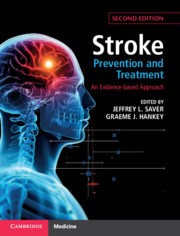Book contents
- Stroke Prevention and Treatment
- Stroke Prevention and Treatment
- Copyright page
- Dedication
- Contents
- Contributors
- Preface
- Part I Foundations
- Part II Systems of Care
- Part III Acute Treatment of Ischaemic Stroke and Transient Ischaemic Attack
- Chapter 5 Supportive Care during Acute Cerebral Ischaemia
- Chapter 6 Reperfusion of Ischaemic Brain by Intravenous Thrombolysis
- Chapter 7 Reperfusion of the Ischaemic Brain by Endovascular Thrombectomy and Thrombolysis
- Chapter 8 Collateral Flow Enhancement: Blood Pressure Lowering and Alteration of Blood Viscosity
- Chapter 9 Acute Antiplatelet Therapy for the Treatment of Ischaemic Stroke and Transient Ischaemic Attack
- Chapter 10 Acute Anticoagulant Therapy for the Treatment of Acute Ischaemic Stroke and Transient Ischaemic Attack
- Chapter 11 Treatment of Brain Oedema
- Chapter 12 Neuroprotection for Acute Brain Ischaemia
- Part IV Acute Treatment of Haemorrhagic Stroke
- Part V Prevention
- Part VI Stroke Rehabilitation and Recovery
- Index
- References
Chapter 9 - Acute Antiplatelet Therapy for the Treatment of Ischaemic Stroke and Transient Ischaemic Attack
from Part III - Acute Treatment of Ischaemic Stroke and Transient Ischaemic Attack
Published online by Cambridge University Press: 15 December 2020
- Stroke Prevention and Treatment
- Stroke Prevention and Treatment
- Copyright page
- Dedication
- Contents
- Contributors
- Preface
- Part I Foundations
- Part II Systems of Care
- Part III Acute Treatment of Ischaemic Stroke and Transient Ischaemic Attack
- Chapter 5 Supportive Care during Acute Cerebral Ischaemia
- Chapter 6 Reperfusion of Ischaemic Brain by Intravenous Thrombolysis
- Chapter 7 Reperfusion of the Ischaemic Brain by Endovascular Thrombectomy and Thrombolysis
- Chapter 8 Collateral Flow Enhancement: Blood Pressure Lowering and Alteration of Blood Viscosity
- Chapter 9 Acute Antiplatelet Therapy for the Treatment of Ischaemic Stroke and Transient Ischaemic Attack
- Chapter 10 Acute Anticoagulant Therapy for the Treatment of Acute Ischaemic Stroke and Transient Ischaemic Attack
- Chapter 11 Treatment of Brain Oedema
- Chapter 12 Neuroprotection for Acute Brain Ischaemia
- Part IV Acute Treatment of Haemorrhagic Stroke
- Part V Prevention
- Part VI Stroke Rehabilitation and Recovery
- Index
- References
Summary
Aspirin 160–300 mg daily started within 48 h of onset of acute ischaemic stroke is associated with a small beneficial reduction in recurrent ischaemic stroke (6 fewer per 1000 patients treated) and pulmonary embolism (1.5 fewer per 1000) that outweighs increased risk of bleeding (2 extra symptomatic ICHs and 4 extra major extracranial haemorrhages). The net effect is that, for every 1000 patients treated early with aspirin, 22 have reduced long-term disability, including 11 more achieving full recovery. Only two single antiplatelet regimens have been compared head to head against aspirin alone: cilostazol (a phosphodiesterase inhibitor) performed similarly to aspirin; ticagrelor (a GP IIa/IIIb receptor antagonist) showed tended to reduce ischaemic events but increased minor bleeding and dyspnea. In minor, non-cardioembolic ischaemic stroke or TIA, early dual antiplatelet therapy (DAPT) has shown advantages over early monotherapy. Most well-studied is clopidogrel and aspirin, with similar findings for dipyridamole and aspirin. DAPT reduces all-type (ischaemic and haemorrhagic) recurrent stroke (27 fewer per 1000 treated patients), but minimally increases major extracranial bleedings (3 more per 1000). Confining DAPT to the first 3 w maximizes the benefit to harm ratio. Anticoagulants alone and arterial-dose anticoagulants added to antiplatelet agents offer no net advantages over antiplatelet drugs alone. Venous prophylaxis-dose anticoagulants and aspirin, compared with aspirin alone, reduced recurrent ischaemic stroke more than it tend increased major extracranial haemorrhage.
Keywords
- Type
- Chapter
- Information
- Stroke Prevention and TreatmentAn Evidence-based Approach, pp. 154 - 178Publisher: Cambridge University PressPrint publication year: 2020



